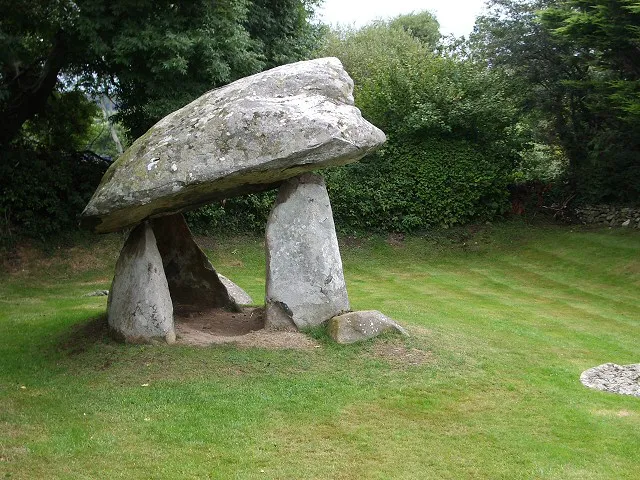Carreg Coetan Arthur is a Neolithic dolmen located in Newport, Pembrokeshire, Wales. This ancient burial chamber dates back to around 3000 BC and stands as a testament to the region’s prehistoric past. The name itself translates to ‘Arthur’s Quoit’, which is a reference to the legendary King Arthur, though there is no historical connection to the figure. The site consists of a large capstone resting on upright stones, typical of the megalithic tombs found across Western Europe. Carreg Coetan Arthur is a significant example of early Neolithic funerary practices and provides insight into the rituals and beliefs of the people who built it.
Get your dose of History via Email
Historical Background of Carreg Coetan Arthur
The discovery of Carreg Coetan Arthur dates back to the 18th century, though it likely stood unnoticed for millennia before. Local antiquarians first recorded the site, recognizing its historical importance. The dolmen is attributed to the Neolithic people of Wales, who constructed it as a burial chamber. There is no definitive evidence of who specifically built it, but it aligns with the practices of Neolithic communities in the area.
Carreg Coetan Arthur has not been the scene of any known historical events since its construction. However, it has sparked the imagination and curiosity of locals and visitors alike. The dolmen has remained relatively undisturbed, with no significant alterations or inhabitations by later cultures. Its endurance through time offers a direct connection to the Neolithic period.
Archaeological studies have not identified any particular individuals associated with the dolmen. It is presumed to have served as a communal burial site, typical of the era’s practices. The lack of extensive excavation means that much of its history remains a mystery, preserved beneath the Welsh soil.
While Carreg Coetan Arthur is not as widely known as other megalithic sites, it is nonetheless an important piece of prehistoric heritage. It contributes to the broader understanding of Neolithic structures across Europe. The dolmen’s simplicity and longevity make it a poignant reminder of our ancient past.
There have been no significant findings to suggest that Carreg Coetan Arthur played a role in any major historical events beyond its intended use. It stands as a solitary monument, its history largely untold and its stories held within the stones themselves.
About Carreg Coetan Arthur
Carreg Coetan Arthur is a classic example of a Neolithic dolmen. The structure consists of a large capstone, which is estimated to weigh around 16 tons. The capstone rests upon two upright stones, creating a covered space beneath. This space likely served as a burial chamber, where the remains of the dead were placed.
The dolmen’s construction reflects the engineering skills of Neolithic societies. They transported and erected massive stones without the aid of modern machinery. The exact methods used remain a subject of speculation, but it likely involved a combination of manpower, ropes, and wooden rollers or sledges.
The stones used in Carreg Coetan Arthur’s construction are local to the area. This suggests that the builders sourced materials from nearby, which was a common practice in megalithic tomb construction. The choice of stones and their placement would have held significance for the builders, though the exact meanings are lost to time.
Architecturally, the dolmen is simple yet effective. It has withstood thousands of years of Welsh weather, a testament to its builders’ skill. The capstone’s sheer size and the precision of its placement over the uprights are particularly noteworthy.
Despite its age, Carreg Coetan Arthur remains in good condition. It is a protected monument, ensuring its preservation for future generations to study and appreciate. The site is accessible to the public, offering a tangible link to the distant past.
Theories and Interpretations
Carreg Coetan Arthur, like many Neolithic sites, is shrouded in mystery. The primary theory is that it served as a communal burial site. This aligns with similar dolmens across Europe, which were often part of larger ceremonial landscapes.
Some theories suggest that the dolmen had astronomical alignments or was part of a wider spiritual belief system. However, without extensive archaeological evidence, these theories remain speculative. The site’s simplicity makes it difficult to draw definitive conclusions about its use.
There are no written records from the time of Carreg Coetan Arthur’s construction. Therefore, interpretations of the site are based on comparisons with other Neolithic structures. The dolmen’s design is consistent with tombs intended for multiple burials over time.
Dating of the site has been carried out through relative dating methods. These include comparing pottery styles and other artifacts found in similar contexts. Absolute dating methods, such as radiocarbon dating, have not been extensively applied to Carreg Coetan Arthur.
The lack of excavation at the site means that many questions about Carreg Coetan Arthur remain unanswered. Future archaeological work could provide further insights into the dolmen’s origins, use, and the people who built it.
At a glance
- Country: Wales
- Civilization: Neolithic
- Age: Approximately 5,000 years old (circa 3000 BC)
Conclusion and Sources
- Wikipedia: https://en.wikipedia.org/wiki/Carreg_Coetan_Arthur
- Historic Wales – Official Government Site: https://cadw.gov.wales/

